Bare with me as I wrote this 13 years ago and just found it on my PC…LOL
Trying to fit a word “consistency” in a same sentence with “surf fishing” is akin to words “no traffic” and “LIE”, Yeah ,they both happen occasionally but the duration is usually short lived. The spots that produce fish one day shut down the next for no apparent reason, other than the fact you weren’t there yesterday but you hear about it and showed up “today”. Beach structure undergoes changes after each onshore blow and baitfish is known to stage disappearing act with regularity. The only “consistency” in this sport is that is inconsistent. There are few concepts that have over the years became a part of surfcasting lore. Part fiction, part wishful thinking and a lot of misinformation went a long way to make these “cant miss” occurrences an accepted practice in the eyes of some surfcasters. Many have accepted these ,for a lack of a better word “misconceptions” as if they were gospel passed on by some surfcasting Gods from good old days. I think this is a mistake. A surfcaster should never  box himself into a narrow frame of mind. A good surfcaster should always be willing to expand his horizon in search of a new feeding ,bait or weather patterns. Its bad enough already we as surfcasters are limited to certain areas because of access restrictions .
box himself into a narrow frame of mind. A good surfcaster should always be willing to expand his horizon in search of a new feeding ,bait or weather patterns. Its bad enough already we as surfcasters are limited to certain areas because of access restrictions .
Weakfish feed only at night. Really?
The “cheat sheet” always said that weakfish come to play only at night and if you want to tangle with them then you should do the same. This is simply an exaggeration and nothing more than that. Heck, my two biggest weaks, were caught around midday on cloudless, sunny days with temperature pushing well into the 90’s in August. I’ll agree that if you seek quantity or consistence, nighttime offers much better opportunities to succeed. But if you can find deep water within casting proximity of the shore and if that area is not a highly traveled by boats in daytime, your chances of tangling up with a weakfish are quite good. Jetties and rocky seawalls due to their ability to offer baitfish shelter are first places you should explore with deep holes in back bays reachable with a cast from shore a good second choice.
Fish the higher tides
If I heard it once I heard it thousand times “best fishing is found on first of outgoing tide”. First let me explain where I am coming from to give you better understanding why I think this kind of thinking if flawed. I don’t fish areas without current flow. Although few times each season you might find me on a open beach throwing bait, 99% of the time I prefer to cast artificials in areas with current flow.Gamefish seek structure which when coupled with current flow create opportunistic feeding areas in which they are able to use structure and flow to their advantage. Their approach to feeding is simple, ”use least amount of energy to fill their belies”. In the area that I primarily fish, be that mouth of the inlets or back bays, first of the outgoing tide feature little or in some cases no current flow. For example, in Jones inlet ebbing current does not start to noticeably flow until one to two hours after the high tide, depending on moon stage and wind direction. Another reason why “high water out” is overrated is that there is just too much darn water at the time of high tide therefore increasing the territory the baitfish can use to hide from predators. I prefer decreased water level to condense the baitfish making it easier for gamefish to coral and ambush. At this stage of the tide current is not flowing therefore rips are not formed and bait is dispersed all over the place.No two places are the same and there are plenty of places where first of the outgoing is the best time to fish. Heck, last of the incoming tide has probably been the best time to fish the Montauk Lighthouse since they built the place. But each spot has its own tide preferences. Generalities about surf fishing usually never work. The tide that works in one spot might suck at another spot. The mthly thing that works in every place is the fact that you cant catch them from your couch.
And stay away from bottom of the tide…
Strangely enough, the low water or low tide stage is detested by many surfcasters who wrongly assume that you need deep water in order too catch fish. Nothing could be further from the truth. Many of my favorite hunting grounds are most productive during the last two hours of outgoing tide or the first hour of incoming water as baitfish is forced to congregate in less and less water, concentrating them in numbers that makes it appealing to gamefish. Remember that no gamefish worth its salt, be that bass, blue or weakfish will chase the baitfish around the ocean, expanding more energy in the process than they will gain it once they consume. Unlike you and me, gamefish don’t feed for “fun” like we do when we grab that bag of chips just because its there. They feed to survive and are constantly searching for opportunities to do so in the manner that is most advantageous to their cause, meaning eat as much as possible while spending least amount of energy doing so.
There is no denying that the most visually exciting part of surfcasting is enticing a gamefish to rise from the bottom and hit a top water lure. Water spraying everywhere and at times near misses, seem to only enrage the fish even more as it attacks the plug again and again until hooks are firmly planted in its jaws. But visual action notwithstanding, is popping plugs productive enough to justify their standing as one of the most commonly used lures in daytime? I believe for every fish that you raise to the surface to attack a popping plug, there are probably dozens cruising under the surface ,not showing any sign of their presence. So if you are raising fish but not hooking up as often as you would like try going under the surface with a bucktail or a similar lure. I would bet that your score goes way up.
Is dusk overrated?
Surfcasting around the time of dusk easily attracts more anglers than any other time of a day or night. Part of the reason for this is obviously due to our work and family obligations, which take up most of the daylight hours. But is it most productive time to fish? Judging by sheer numbers of surfcasters present in the water the answer seems to be overwhelmingly yes. But following the crowds in this instance might be a wrong thing to do. Tide, currents and wind conditions have greater impact on when the fish will become active than the time of the day itself. Having said that fishing during the night hours and at first light have always been most productive during the course of the season if we take out of equation those precious few weeks in the fall when bass and blues go on their feeding binges in the daytime. During the summer months water temperatures are at their highest during late afternoon and gamefish generally seek shelter at this time in the deep holes of back bays or cool ocean waters. Add to that a swimming public and boat traffic and you have a recipe for a lousy fishing. Think of it this way, do you really think that after hundreds of boats have crisscrossed the inlet in search of fluke filets during the day the fish will flip the switch, forget about the 70+ degree water temperature and go on the feeding binge, just because the sun its dipping on horizon? I wish it were that easy. The fact is if you seek consistent success with good size fish you must concentrate on night tides. It might take some sleep deprivation but in this sport you only get out what you put in.
Leaders – what for?
Thankfully, majority of anglers have come top realization that they need a leader between their running line and a lure. They are aware that their main lines, be that mono or braid is not design to withstand abrasion from the rocks or sharp teeth of gamefish as leader material is. Even the jaw of striped bass which lacks a defined teeth structure will weaken your line when rubbed against it. Considering that bluefish are able to cut even the heaviest leader in seconds with their razor sharp teeth you can only imagine how long you will have service of your lure if you are casting without the leader while bluefish are present in the area. Leaders take tremendous punishment from our tackle, from absorbing shocks during casts, taking a hit from the fish or being held onto while releasing fish. Trying to grab your braided line while you have a trashing fish on business end is a recipe for a disaster. Due to its thin diameter and strength the braid will cut your hands to the bone in short order with a trashing fish on. The only reasonable argument against use of leader that makes sense at all is that by adding two more knots to out line we increase the chance that our rig will fail. True, but if you take the time to draw your knots slowly, making sure you wet them with saliva before you tighten them and paying attention that your loops on the finished knot are one on top of another instead of crisscrossed you virtually eliminate the possibility of failure. Most plugs are lost because of poorly tied knots or open snaps, not because your leader broke. Then there are those who insist that a fish can see a leader and therefore shy away from a lure that is attached to it. Yeah, maybe in Bahamas but not in the murky waters of Northeast. Shifting sediment, plankton growth and fast current make the waters we fish in cloudy on the best of days. Most of the time I can’t see my boots while wading in the water and that’s size 13 Wide, and you are worried about see-through piece of monofilament?
Bunker heads
I have friends who insist on using these 1 and ½ slivers of bunker and are often left wondering why are they catching primarily small bass. I tried over the years to get them to chunk a head out once in awhile but they do it with enthusiasm I usually reserve for cold pizza. Unfortunately they are not in the minority among surfcasters, as many are shying away from tossing heads or even large chunks. You heard about the expression “big lures catch big fish “ right? Well, same of that can be said when baitfishing too. Think about it for a moment’s a decent bass, not monster, but anything above teen fish can swallow adult bunker whole! And you are wondering about your chunk being too big? Add to the equation that bass feeds head first and swallows everything they eat whole and a head should be you favorite piece of bunker, not the least favorite one. Part of the aversion from tossing heads is use of a tackle not suited for baitfishing in general. Six to eight ounces of lead plus a head requires beefy tackle and if your rod cant handle this load you are most likely fishing with what I like to call a “spaghetti” rod, a stick too light for the job. I use a conventional outfit, Lamiglas 1361MH, an 11 foot stick and I can honestly say that even with 8&bait this rod is just getting started to load. Another reason for using heads is the fact that small fish, sand sharks and skates will often leave the head alone while they mercilessly munching on your buddies chunk. I was fishing with few buddies and after landing third consecutive sand shark I was getting annoyed so when I re-baited, I cut bunker in a half and impaled the front half on the hook under the chin and out thru the nose. Of course my friend were chuckling as I lobed this monstrosity into the surf. They faces froze in grimaces when within few minute I slid a 35lb bass on the sand. Two heads are better than one, right?
Yes, i had few “extra” pounds then..lol

just a heads up
Night Crew shirts and hoodies are back in the online store after a long absence . more stuff coming up..new color on caps, new hats, striper pins

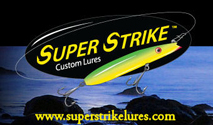

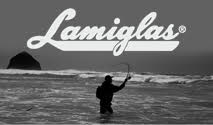


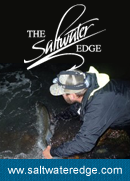
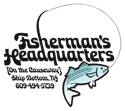
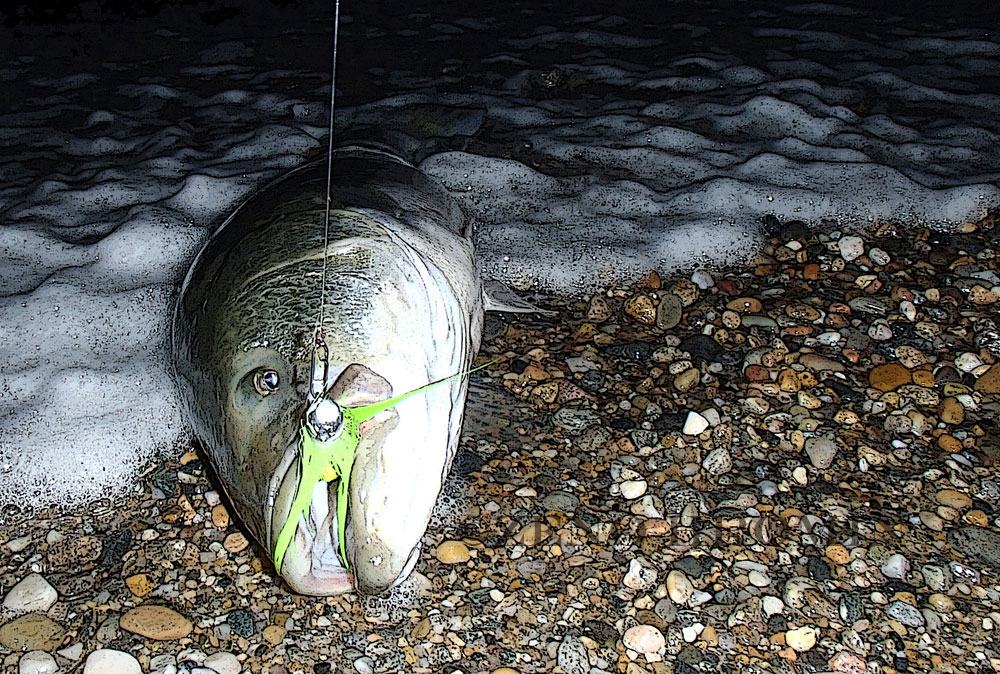


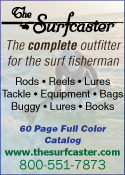


Good read Thanks for sharing.
↓